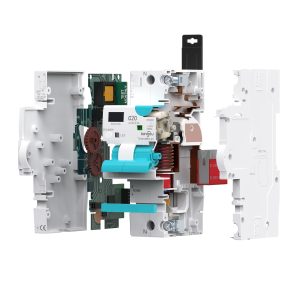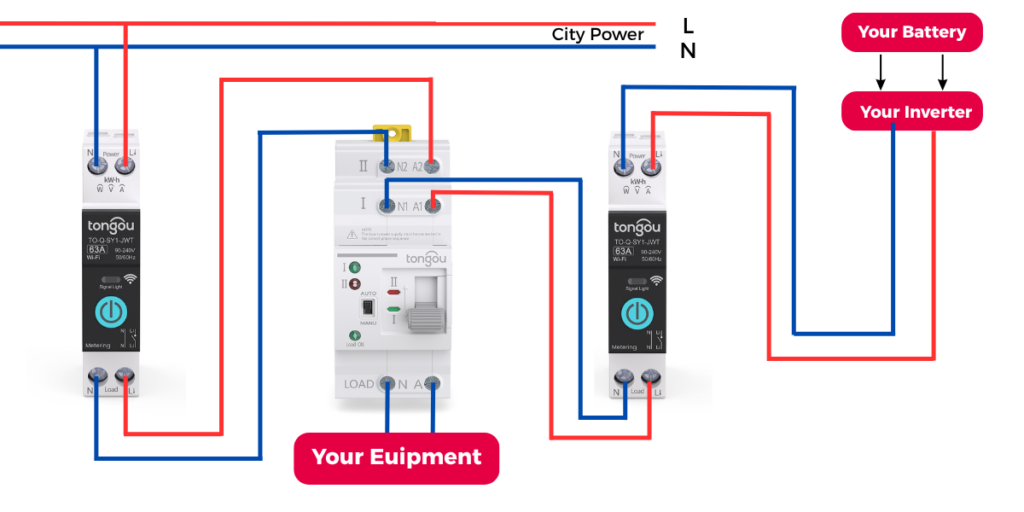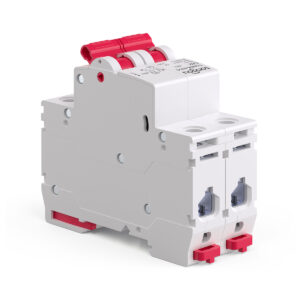
RCBO Trips at Night? Causes, Diagnosis, and Lasting Fixes
RCBO Trips at Night? Causes, Diagnosis, and Lasting Fixes Already know what an RCBO is? Great. This page skips the basics and focuses on nocturnal
As solar and battery systems become more common in homes and businesses, users are looking for reliable, automatic power transfer between solar, battery, and grid sources. This is where the Automatic Transfer Switch (ATS) — or solar transfer switch — plays a vital role.
An ATS ensures a seamless transition between your solar inverter, battery backup, and utility grid — keeping your lights on, equipment running, and power stable without manual intervention.
A solar transfer switch is a specialized version of a standard ATS designed for solar and PV systems.
While a conventional ATS switches between two AC sources (such as generator and grid), a solar-compatible ATS coordinates DC and AC sources, including:
This makes it an essential part of a hybrid energy system, allowing automatic power selection based on availability and priority.
In practice, a solar transfer switch is never working alone. It is part of a PV system that has been designed according to recognized standards such as NEC Article 690 for photovoltaic systems or IEC 62548 for PV array design, which define how DC wiring, protection devices and disconnects must be sized and installed for safety. Linking your ATS to a system that already follows these codes makes the whole installation much more reliable and inspection-friendly.
When solar energy is available, the ATS prioritizes the inverter and battery supply to power your loads.
If solar generation drops or the battery runs low, the ATS automatically switches to the utility grid.
Advanced models, such as the Tongou ATS, integrate delay timing, phase monitoring, and voltage detection to prevent backfeed and ensure smooth changeover — protecting both your inverter and connected devices.
Many modern inverters include a basic transfer function, but it’s not a true ATS.
Here’s how they differ:
| Feature | Inverter Built-in Switch | External ATS (like Tongou) |
|---|---|---|
| Switching Capacity | Limited to inverter rating | Handles higher loads |
| Safety Isolation | Minimal | Full double-pole isolation |
| Grid Synchronization | Often delayed or manual | Automatic, real-time detection |
| Lifespan | Lower (due to heat and usage) | Higher mechanical endurance |
| Flexibility | Fixed within inverter | Works across multiple sources |
In short, while inverter switches are suitable for small systems, a dedicated ATS ensures professional-level safety, durability, and control.
Before installation, always ensure your ATS is rated for solar applications and matches your system’s voltage and current.
Source 1: Utility Grid
Source 2: Inverter / Battery Output
Load: Main distribution line
1. Isolate all power sources.
2. Connect grid and inverter outputs to the designated ATS terminals.
3. Wire the load output to your home or business distribution board.
4. Configure delays and switching priority as per system design.
For hybrid systems, refer to the double-pole solar ATS wiring diagram provided in Tongou’s technical documents.
| Symptom | Possible Cause | Suggested Fix |
|---|---|---|
| Load still receives power when “off” | Single-pole connection error | Use a proper double-pole ATS |
| Flickering or unstable power | Voltage sag or backfeed | Check voltage tolerance; enable protection |
| No switching to solar | Signal or logic error | Verify control wiring and inverter output |
| Overload trips frequently | Load near ATS limit | Recalculate total load; upgrade capacity |
| App shows no monitoring | Network setup error | Check firmware, WiFi signal, or IoT settings |
When selecting an ATS for your solar or battery setup, consider:
Rated current and voltage (match inverter output and grid input)
Switching speed and delay time
Double-pole isolation for safety
Compatibility with PV and battery hybrid systems
When you’ve completed the previous steps, you’re already able to use an automatic transfer switch to connect city power and your solar power, achieving seamless electricity usage. Congratulations, this is undoubtedly a crucial step towards energy independence. However, in today’s pursuit of ultimate energy efficiency and convenient control, we can’t help but ponder: What’s the next goal: intelligent control? Can it automatically switch to solar power when solar energy is abundant? Let’s delve into the following topic with these thoughts in mind:

As illustrated above, this is not just a simple ATS system; it’s a meticulously designed smart energy management ecosystem from Tongou. It ingeniously combines the Tongou TOATS automatic transfer switch with multiple TO-Q-SY1-JWT smart metering and control modules, offering you an unparalleled control experience:
Acting as the “traffic hub” of the entire system, the Tongou TOATS is responsible for seamless switching between City Power and Your Inverter. It ensures that during grid outages or according to your specific programmed strategies, the power supply can quickly and stably switch from one source to another, guaranteeing continuous operation for Your Equipment. Its reliability is the foundation of your smart energy management.
Left Module: Connected between City Power and Your Equipment, it serves as the “Grid Energy Consumption Manager.” It precisely measures the real-time electricity (kWh) consumed by your equipment from the city grid, providing detailed energy usage data.
Right Module: Cleverly connected between Your Inverter and the entire load system, this is the “Renewable Energy Production & Consumption Manager.” It not only monitors the inverter’s output but also measures how much solar power is consumed by your equipment.
Synchronized Operation of Both Modules: Both smart metering modules connect via Wi-Fi to the Tongou Smart App. Together, they offer unprecedented energy transparency, giving you a holistic view of grid consumption, solar utilization.
In addition, the smart switch module can also achieve automated settings through timing and smart scene functions, set programs in advance, and switch intelligently.
To make the concept more concrete for readers, you can show how an ATS works in typical field projects:
A homeowner installs a 6–10 kW roof-top PV array with a hybrid inverter and a battery pack. During the day, loads are powered primarily by the inverter and battery, while surplus energy charges the battery. The solar ATS monitors both the grid and inverter output. Under normal conditions it keeps the house supplied from the inverter side; when PV generation drops and the battery reaches a low state of charge, the ATS automatically transfers to the utility grid, so the family never notices a change. During an outage, the ATS isolates the home from the grid and allows the inverter and battery to supply critical loads safely.
A small shop uses a combination of PV, battery storage and grid supply to keep lighting, POS systems and refrigeration running. Here the ATS sits between the grid and the inverter output feeding the main distribution board. During business hours, it prioritizes solar and battery energy to reduce electricity bills; after hours, when loads are low, the ATS can be programmed to switch to grid power and let the battery rest. This example helps readers see the ATS as a tool for both reliability and energy-cost optimization.
In remote telecom towers, farm pump stations or off-grid cabins, solar and batteries are often the primary source, with the grid or a generator as backup. An outdoor-rated ATS ensures that, if the inverter shuts down due to prolonged bad weather, the loads are seamlessly transferred to the backup source. When solar and battery recover, the ATS can switch back according to predefined priorities. For operators, this eliminates manual changeover, reduces site visits and ensures that communication equipment or pumps stay online.
In every modern solar and battery system, the Automatic Transfer Switch is more than just a switch — it’s the decision-maker that keeps your energy flow efficient, safe, and uninterrupted.
Whether you’re upgrading a home PV setup or managing a commercial hybrid system, choosing the right solar transfer switch ensures long-term performance and stability.

Johnson Lim is the General Manager of Changyou Technology and has over 10 years of experience in circuit protection technology and residential electrical safety. He is committed to developing and producing safer and smarter electrical products.

RCBO Trips at Night? Causes, Diagnosis, and Lasting Fixes Already know what an RCBO is? Great. This page skips the basics and focuses on nocturnal

MCB B/C/D Curves in Practice: How Inrush Current Shapes Your Choice This guide assumes you already know what an MCB is. If you need a

SPD Coordination for Solar PV and EV Charging: Where to Place Type 1/2/3 Already know the difference between Type 1/2/3 and AC vs DC SPDs?

MCB vs MCCB: A Practical Guide to Icu/Ics and IEC 60898 vs 60947-2 This guide assumes you already know what a breaker is. If you

tongou was established in 1993 and is the trademark of Changyou Technology. We position ourselves as providers of intelligent product solutions for high and low voltage electrical systems, taking on solving customers’ pressures and challenges as our responsibility and creating value for them. We utilize intelligent products to serve global customers, making life smarter and more convenient to benefit your life.
Paidong Industrial Zone Qiligang,Yueqing City,Zhejiang province,China.
Sales: [email protected]
After-sales: [email protected]
© 2025 Changyou Technology. All Rights Reserved.

